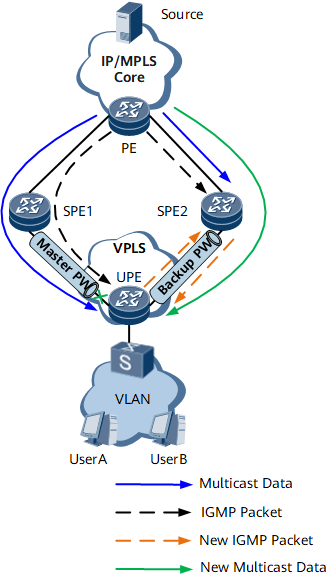Rapid Multicast Data Forwarding on a Backup Device
Principles
Multicast services have relatively high demands for real-time transmissions. To ensure uninterrupted delivery of multicast services, master and backup links and devices are deployed on a VPLS network with a UPE dual-homed to SPEs. In the networking shown in Figure 1, a UPE is connected to two SPEs through a VPLS network. The PWs between the UPE and SPEs work in master/backup mode. Multicast services are delivered from a multicast source to users attached to the UPE.
This networking allows unicast services to be transmitted properly, but there are problems with the transmission of multicast services. Multicast protocol and data packets are blocked on the backup PW and this prevents the backup SPE (SPE2) from learning multicast forwarding entries. As a result, SPE2 has no forwarding entries, and, in the event of a master/backup SPE switchover, it cannot begin forwarding multicast data traffic immediately. The PE must first resend an IGMP Query message and users attached to the UPE must reply with Report messages before SPE2 can learn multicast forwarding entries through the backup PW and resume the forwarding of multicast data packets. As a result, services are interrupted on the UPE for a long period of time, and network reliability is adversely affected.

If the primary and secondary PWs in this networking are hub PWs, split horizon still takes effect, meaning that protocol and data packets are not transmitted from the primary PW to the secondary PW.
To address this problem, rapid multicast traffic forwarding is configured on the backup device, SPE2. SPE2 sends an IGMP Query message to the UPE along the backup PW, and receives an IGMP Report message from the UPE to create a Layer 2 multicast forwarding table. Although the backup PW cannot be used to forward multicast data traffic, it can be used by SPE2 to send an IGMP Query message. If there is a switchover and the backup PW becomes the master, SPE2 has a Layer 2 multicast forwarding table ready to use and can begin forwarding multicast data traffic immediately. This ensures uninterrupted delivery of multicast services.
Related Concepts
The following concepts are involved in rapid multicast data forwarding on a backup device:
Master and backup devices
Between the devices to which a device directly connected to user hosts are dual-homed through a VPLS network, the working device is the master, and the device that protects the working device is the backup.
Primary and backup links
The physical link between the device directly connected to user hosts and the master device is the primary link. The physical link between the device directly connected to user hosts and backup device is the backup link.
Primary and backup PWs
The PW between the device directly connected to user hosts and the master device is the primary PW. The PW between the device directly connected to user hosts and the backup device is the backup PW.
Other Functions
If the upstream and downstream devices (SPE and UPE) are not allowed to receive IGMP messages that carry the same source MAC address but are sent from different interfaces, the backup device needs to be configured to replace the source MAC addresses carried in IGMP messages.
- After rapid multicast traffic forwarding is configured, the UPE receives IGMP Query messages from both SPE1 and SPE2. Both messages carry the same MAC address. If MAC-flapping or MAC address authentication has been configured on the UPE, protocol packets that are received by the UPE through different interfaces but carry the same source MAC address will be filtered out. The backup SPE can be configured to change the source MAC addresses of packets to its MAC address before sending IGMP Query messages along the backup PW. This allows the UPE to learn two different router ports and send IGMP Report and Leave messages from attached users to SPE1 and SPE2.
- Similarly, if MAC-flapping or MAC address authentication has been configured on the PE, the backup SPE needs to be configured to change the source MAC addresses of received IGMP Report or Leave messages to its MAC address before sending them to the PE.
Deployment Scenarios
Rapid multicast data forwarding on a backup device is used on VPLS networks that have a device dual-homed to upstream devices through PWs.
Benefits
Rapid multicast data forwarding on a backup device provides the following benefit:
- After a master/backup device switchover is performed, multicast data can be quickly forwarded on the backup device. This ensures reliable multicast service transmission and enhances user experience.
